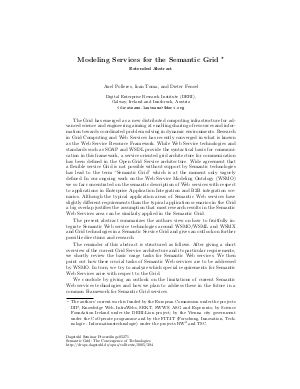Modeling Services for the Semantic Grid
Authors Axel Polleres, Ioan Toma, Dieter Fensel
-
Part of:
Volume:
Dagstuhl Seminar Proceedings, Volume 5271
Part of: Series: Dagstuhl Seminar Proceedings (DagSemProc) - License:
 Creative Commons Attribution 4.0 International license
Creative Commons Attribution 4.0 International license
- Publication Date: 2005-12-20
File

PDF
DagSemProc.05271.6.pdf
- Filesize: 144 kB
- 6 pages
Document Identifiers
Subject Classification
Keywords
- Semantic Web Services
- WSMO
Metrics
- Access Statistics
-
Total Accesses (updated on a weekly basis)
0PDF Downloads0Metadata Views
Abstract
The Grid has emerged as a new distributed computing infrastructure for ad- vanced science and engineering aiming at enabling sharing of resources and infor- mation towards coordinated problem solving in dynamic environments. Research in Grid Computing and Web Services has recently converged in what is known as the Web Service Resource Framework. While Web Service technologies and standards such as SOAP and WSDL provide the syntactical basis for communi- cation in this framework, a service oriented grid architecture for communication has been defined in the Open Grid Service architecture. Wide agreement that a flexible service Grid is not possible without support by Semantic technologies has lead to the term "Semantic Grid" which is at the moment only vaguely defined. In our ongoing work on the Web Service Modeling Ontology (WSMO) we so far concentrated on the semantic description of Web services with respect to applications in Enterprise Application Integration and B2B integration sce- narios. Although the typical application areas of Semantic Web services have slightly different requirements than the typical application scenarios in the Grid a big overlap justifies the assumption that most research results in the Semantic Web Services area can be similarly applied in the Semantic Grid. The present abstract summarizes the authors view on how to fruitfully in- tegrate Semantic Web service technologies around WSMO/WSML and WSMX and Grid technologies in a Semantic Service Grid and gives an outlook on further possible directions and research. The reminder of this abstract is structured as follows. After giving a short overview of the current Grid Service architecture and its particular requirements, we shortly review the basic usage tasks for Semantic Web services. We then point out how these crucial tasks of Semantic Web services are to be addressed by WSMO. In turn, we try to analyze which special requirements for Semantic Web Services arise with respect to the Grid. We conclude by giving an outlook on the limitations of current Semantic Web services technologies and how we plan to address these in the future in a common Framework for Semantic Grid services.
Cite As Get BibTex
Axel Polleres, Ioan Toma, and Dieter Fensel. Modeling Services for the Semantic Grid. In Semantic Grid: The Convergence of Technologies. Dagstuhl Seminar Proceedings, Volume 5271, pp. 1-6, Schloss Dagstuhl – Leibniz-Zentrum für Informatik (2005)
https://doi.org/10.4230/DagSemProc.05271.6
BibTex
@InProceedings{polleres_et_al:DagSemProc.05271.6,
author = {Polleres, Axel and Toma, Ioan and Fensel, Dieter},
title = {{Modeling Services for the Semantic Grid}},
booktitle = {Semantic Grid: The Convergence of Technologies},
pages = {1--6},
series = {Dagstuhl Seminar Proceedings (DagSemProc)},
ISSN = {1862-4405},
year = {2005},
volume = {5271},
editor = {Carole Goble and Carl Kesselman and York Sure},
publisher = {Schloss Dagstuhl -- Leibniz-Zentrum f{\"u}r Informatik},
address = {Dagstuhl, Germany},
URL = {https://drops.dagstuhl.de/entities/document/10.4230/DagSemProc.05271.6},
URN = {urn:nbn:de:0030-drops-3944},
doi = {10.4230/DagSemProc.05271.6},
annote = {Keywords: Semantic Web Services, WSMO}
}
